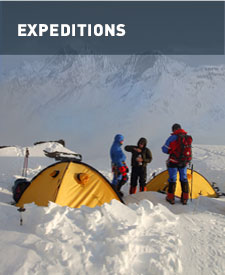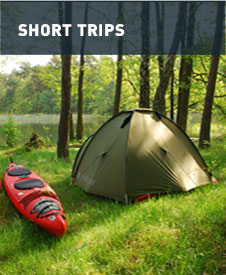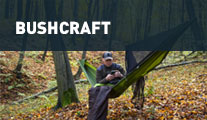Summer camping by a lakeside, in the woods or at a campsite, together with your friends, family or girlfriend is a relaxing and joyful experience. Things change when it comes to spending a night (or a few) in the tent that is put up on snow. Those who have any experience in camping in winter mountains, know the difference. Camping in the “arctic” conditions is a totally different situation.
Tent
The key factor is a tent type. What should you choose? A dome tent? A tunnel tent … or maybe a NS military tent ? The best answer is “the simpler - the better”. But remember that cheaper tents (as they are simple…) are not the better ones. Unfortunately it is just the opposite. A good tent is not a cheap item. It has to be lightweight, small when folded and what is most important – it has to be designed for trouble-free putting up. Perfectly when both skins of the tent (flysheet and the inner canopy ) are fixed together and tent poles cause no trouble during the putting up process. When camping in winter, take spare tent poles (or at least their sections) with you, because they may crack due to very low temperatures, which is quite surprising for users without winter experience. Do not forget also to take ice screws. Sometimes it is very hard to use standard tent pegs on ice.
Personally, I think that tunnel tents or dome tents are the best for winter camping. It is important that the distance between tent skins was quite large in the vestibule area. It would help you to dig a hole (depth approx. 30 cm) in this area, which would increase the temperature in the sleeping section by 2-3ºC. How? Simple Physics! Cold air gathers in the lowest area which is inside the hole.
Dimensions of the tent are also important. For two people sleeping inside – choose a tent designed for at least three persons! Why? Imagine yourself in a tent at night with outside temperatures ranging from -20 to -30ºC. You try to fall asleep in a thick sleeping bag, being wrapped in every piece of clothing you could find; sweatshirts, pants and caps. Sometimes the number of clothing layers would prevent you to zip-up your sleeping bag. When you breathe inside a tent in winter, a mist of exhaled air condense on the internal skin of the tent. After some time a wet layer is formed on tent walls, which should not be touched, as staying dry is crucial for your thermal comfort. After a while you will know that a bigger tent gives you the ability to move. Two years ago, when my brother and I camped in winter using a two person tent, our sleeping bags got wet due to the contact with tent walls. For the rest of the trip instead of cosy and warm sleeping bags we were wrapped in wet rags :).
Sleeping pads
The solution that we have worked out in relation to the thermal insulation of the ground, based on two thick thermal blankets spread on the tent floor. On the top of the blankets we put sleeping pads covered with manually inflated mattresses. And everything would be fine, but during the second night of the camping, one of the mattresses started to leak air through its seams. We couldn’t find the leakage area. Gluing or taping in low temperatures is not an option – even a silver tape did not stick (we had to heat it in hot water). So each night we tossed a coin to decide who would be sleeping on the leaking mattress. In the night, it took approximately 1.5 hour for air to totally escape from the mattress and after this time the contact with cold ground was a real “waking” factor. Re-inflating required some skills as the inflating person had to do turn inside the sleeping bag without leaving it and inflate the mattress, avoiding any contact with tent walls and not waking the sleeping companion. After a few attempts we were quite skilful in these manoeuvres.
Now we know what caused the air leakage. In winter, when we blew hot air into the mattress the exhaled mist turned into small ice crystals inside it and the acted similarly to sharp sand, damaging our mattress. Therefore in winter, it is better to use sleeping pads with a closed cell structure.
Clothes
OK, a sleeping pad is not everything that you have to focus on. Winter nights in a tent require you to sleep fully clothed, but you need a system approach to do it right. Last time, when temperature at night dropped well below -30ºC we put on every piece of clothing that we found in the tent. To protect our legs we used thermal underwear made of merino-wool (similarly as in this year: a set of Nordre and additionally Smartwool), then warm fleece trousers and down-filled pants. For feet we used traditional “highlander” socks bought locally in Białka Tatrzańska (these are the best). We also used a professional and warm Icebreakers, recommended by thermal specialists - Ergo!
As for the upper body, our situation was a bit complicated. First we placed wet socks on the naked body – it was the best way to dry them. Then the thermal underwear mentioned above, and then the following layers: next pairs of wet socks, another layer of thermal underwear, thin fleece (made by Beri), a vest, PrimaLoft® jacket and finally a down-filled jacket. Caps on our heads, and woollen gloves on hands. Totally wrapped, with reduced movability we entered our down-filled sleeping bags. This year, we are provided with all down-filled clothing by Yeti. This company suggested that we should use a larger synthetic sleeping bag as a "sleeve" over the basic sleeping bag (down-filled). This synthetic sleeping bag should secure everything that is inside it against moisture. Yeti is a company with extensive experience and it will customize all required models for us in order to avoid any surprises during the trip.
Sleeping bag
It has to be spacious in order to accommodate additional equipment, including: all electronic devices, spare accumulators and batteries – such treatment ensures their longer operational life. During our last expedition we also put the ski-shoe inserts inside the sleeping bags to prevent their freezing as it would result in injuring our feet. This load didn’t improve the comfort of sleeping at all.
Imagine us sleeping in all the clothes on, wrapped in wet socks (to dry them for the next day) with pockets full of batteries and ski-shoe inserts inside our sleeping bags. Add the air-leaking mattress, the tent that is too small and outside temperature dropping below -30ºC – and you will get the picture…
Michał Jasieński, Torrel Expedition 2012












